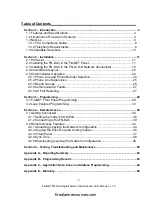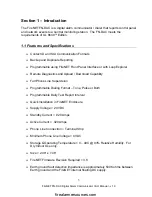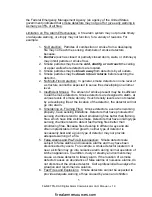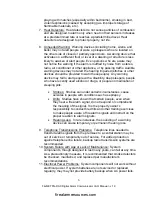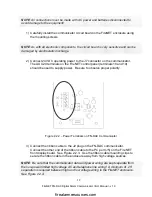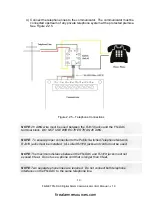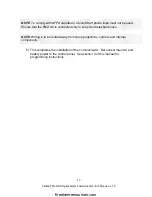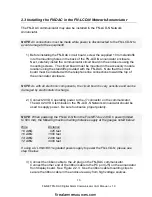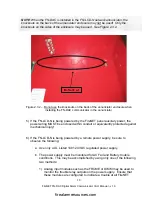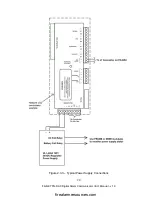
5
FireNET FN-DAC Digital Alarm Communicator I & O Manual - v 1.0
the Federal Emergency Management Agency (an agency of the United States
government) indicated that smoke detectors may not go off or give early warning in
as many as 35% of all fires.
Limitation on Fire Alarm Effectiveness: A fire alarm system may not provide timely
or adequate warning, or simply may not function, for a variety of reasons. For
example:
1. No Detection: Particles of combustion or smoke from a developing
fire may not reach the sensing chambers of smoke detectors
because:
1.
Barriers
(such as closed or partially closed doors, walls, or chimneys)
may inhibit particle or smoke flow.
2. Smoke particles may become
cold, stratify, or not reach
the ceiling
or upper walls where detectors are located.
3. Smoke particles may be
blown away
from detectors by air outlets.
4. Smoke particles may be
drawn into air returns
before reaching the
detector.
2. No Multi-Floor Detection: In general, smoke detectors on one level of
a structure cannot be expected to sense fires developing on another
level.
3. Insufficient Smoke: The amount of smoke present may be insufficient
to alarm smoke detectors. Smoke detectors are designed to alarm, at
various levels of smoke density. If such density levels are not created
by a developing fire at the location of the detector, the detector will not
go into alarm.
4. Smoldering vs. Flaming Fires: Smoke detectors, even when working
properly, have sensing limitations. Detectors that have photoelectric
sensing chambers tend to detect smoldering fires better than flaming
fires, which have little visible smoke. Detectors that have ionizing-type
sensing chambers tend to detect fast flaming fires better than
smoldering fires. Because fires develop in different ways and are
often unpredictable in their growth, neither type of detector is
necessarily best and a given type of detector may not provide
adequate warning of a fire.
5. False Alarms and Pre-Fire Disconnection: Smoke detectors are
subject to false alarms and nuisance alarms and may have been
disconnected by users. For example, a smoke detector located in or
near a kitchen may go into nuisance alarm during normal operation of
kitchen appliances. In addition, dusty or steamy environments may
cause a smoke detector to falsely alarm. If the location of a smoke
detector causes an abundance of false alarms or nuisance alarms, do
not disconnect the smoke detector. Call a professional to analyze the
situation and recommend a solution.
6. Fast Fires and Explosions: Smoke detectors cannot be expected to
provide adequate warning of fires caused by arson and children
firealarmresources.com


